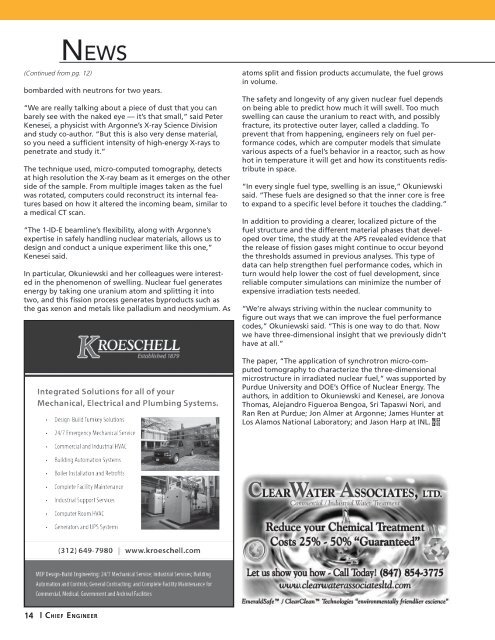CEAC-2021-02-February
You also want an ePaper? Increase the reach of your titles
YUMPU automatically turns print PDFs into web optimized ePapers that Google loves.
(Continued from pg. 12)<br />
News<br />
bombarded with neutrons for two years.<br />
“We are really talking about a piece of dust that you can<br />
barely see with the naked eye — it’s that small,” said Peter<br />
Kenesei, a physicist with Argonne’s X-ray Science Division<br />
and study co-author. “But this is also very dense material,<br />
so you need a sufficient intensity of high-energy X-rays to<br />
penetrate and study it.”<br />
The technique used, micro-computed tomography, detects<br />
at high resolution the X-ray beam as it emerges on the other<br />
side of the sample. From multiple images taken as the fuel<br />
was rotated, computers could reconstruct its internal features<br />
based on how it altered the incoming beam, similar to<br />
a medical CT scan.<br />
“The 1-ID-E beamline’s flexibility, along with Argonne’s<br />
expertise in safely handling nuclear materials, allows us to<br />
design and conduct a unique experiment like this one,”<br />
Kenesei said.<br />
In particular, Okuniewski and her colleagues were interested<br />
in the phenomenon of swelling. Nuclear fuel generates<br />
energy by taking one uranium atom and splitting it into<br />
two, and this fission process generates byproducts such as<br />
the gas xenon and metals like palladium and neodymium. As<br />
atoms split and fission products accumulate, the fuel grows<br />
in volume.<br />
The safety and longevity of any given nuclear fuel depends<br />
on being able to predict how much it will swell. Too much<br />
swelling can cause the uranium to react with, and possibly<br />
fracture, its protective outer layer, called a cladding. To<br />
prevent that from happening, engineers rely on fuel performance<br />
codes, which are computer models that simulate<br />
various aspects of a fuel’s behavior in a reactor, such as how<br />
hot in temperature it will get and how its constituents redistribute<br />
in space.<br />
“In every single fuel type, swelling is an issue,” Okuniewski<br />
said. “These fuels are designed so that the inner core is free<br />
to expand to a specific level before it touches the cladding.”<br />
In addition to providing a clearer, localized picture of the<br />
fuel structure and the different material phases that developed<br />
over time, the study at the APS revealed evidence that<br />
the release of fission gases might continue to occur beyond<br />
the thresholds assumed in previous analyses. This type of<br />
data can help strengthen fuel performance codes, which in<br />
turn would help lower the cost of fuel development, since<br />
reliable computer simulations can minimize the number of<br />
expensive irradiation tests needed.<br />
“We’re always striving within the nuclear community to<br />
figure out ways that we can improve the fuel performance<br />
codes,” Okuniewski said. “This is one way to do that. Now<br />
we have three-dimensional insight that we previously didn’t<br />
have at all.”<br />
The paper, “The application of synchrotron micro-computed<br />
tomography to characterize the three-dimensional<br />
microstructure in irradiated nuclear fuel,” was supported by<br />
Purdue University and DOE’s Office of Nuclear Energy. The<br />
authors, in addition to Okuniewski and Kenesei, are Jonova<br />
Thomas, Alejandro Figueroa Bengoa, Sri Tapaswi Nori, and<br />
Ran Ren at Purdue; Jon Almer at Argonne; James Hunter at<br />
Los Alamos National Laboratory; and Jason Harp at INL.<br />
14<br />
| Chief Engineer


















